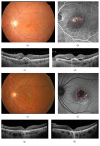Nutritional Supplementation Inhibits the Increase in Serum Malondialdehyde in Patients with Wet Age-Related Macular Degeneration
- PMID: 28243361
- PMCID: PMC5294377
- DOI: 10.1155/2017/9548767
Nutritional Supplementation Inhibits the Increase in Serum Malondialdehyde in Patients with Wet Age-Related Macular Degeneration
Abstract
Purpose. To compare serum levels of malondialdehyde (MDA) in patients with wet age-related macular degeneration (wAMD), patients with dry AMD (dAMD), and patients without AMD and to evaluate the efficacy of nutritional supplementation for treating elevated serum MDA in patients with wAMD. Methods. MDA levels were measured in sera from 20 patients with wAMD, 20 with dAMD, and 24 without AMD. Patients with wAMD were randomized to receive or not receive nutritional supplementation (10 patients in each group), and MDA levels were measured after 3 months of treatment. Results. MDA levels in patients with wAMD were significantly greater compared with patients without AMD. In eyes with wAMD, there was a significant correlation between MDA levels and choroidal neovascularization lesion area. Serum MDA levels decreased in most patients that received supplementation and significantly increased in those who did not. Conclusion. Baseline serum MDA levels were elevated in patients with wAMD, and MDA levels were directly correlated with choroidal neovascularization lesion area. In addition, nutritional supplementation appeared to exert a protective effect against oxidative stress in patients with wAMD.
Conflict of interest statement
The authors declare that there is no conflict of interests regarding the publication of this paper.
Figures



Similar articles
-
Serum malondialdehyde, monocyte chemoattractant protein-1, and vitamin C levels in wet type age-related macular degeneration patients.Ther Adv Ophthalmol. 2020 Sep 30;12:2515841420951682. doi: 10.1177/2515841420951682. eCollection 2020 Jan-Dec. Ther Adv Ophthalmol. 2020. PMID: 33062929 Free PMC article.
-
Associations between the Complement System and Choroidal Neovascularization in Wet Age-Related Macular Degeneration.Int J Mol Sci. 2020 Dec 21;21(24):9752. doi: 10.3390/ijms21249752. Int J Mol Sci. 2020. PMID: 33371261 Free PMC article. Review.
-
Effect of (R)-α-lipoic acid supplementation on serum lipids and antioxidative ability in patients with age-related macular degeneration.Ann Nutr Metab. 2012;60(4):293-7. doi: 10.1159/000338444. Epub 2012 Jun 1. Ann Nutr Metab. 2012. PMID: 22678104 Clinical Trial.
-
Association of focal choroidal excavation with age-related macular degeneration.Invest Ophthalmol Vis Sci. 2014 Sep 4;55(9):6046-54. doi: 10.1167/iovs.14-14723. Invest Ophthalmol Vis Sci. 2014. PMID: 25190653
-
MALONDIALDEHYDE LEVELS IN PATIENTS WITH AGE-RELATED MACULAR DEGENERATION: A Systematic Review and Meta-analysis.Retina. 2020 Feb;40(2):195-203. doi: 10.1097/IAE.0000000000002574. Retina. 2020. PMID: 31972788
Cited by
-
Diacron reactive oxygen metabolites and biological antioxidant potential tests for patients with age-related macular degeneration.BMC Ophthalmol. 2020 Feb 18;20(1):56. doi: 10.1186/s12886-020-01334-y. BMC Ophthalmol. 2020. PMID: 32070305 Free PMC article.
-
Role of Oxidative Stress in Retinal Disease and the Early Intervention Strategies: A Review.Oxid Med Cell Longev. 2022 Oct 14;2022:7836828. doi: 10.1155/2022/7836828. eCollection 2022. Oxid Med Cell Longev. 2022. PMID: 36275903 Free PMC article. Review.
-
Serum malondialdehyde, monocyte chemoattractant protein-1, and vitamin C levels in wet type age-related macular degeneration patients.Ther Adv Ophthalmol. 2020 Sep 30;12:2515841420951682. doi: 10.1177/2515841420951682. eCollection 2020 Jan-Dec. Ther Adv Ophthalmol. 2020. PMID: 33062929 Free PMC article.
-
Oxidative and Nitrosative Stress in Age-Related Macular Degeneration: A Review of Their Role in Different Stages of Disease.Antioxidants (Basel). 2021 Apr 23;10(5):653. doi: 10.3390/antiox10050653. Antioxidants (Basel). 2021. PMID: 33922463 Free PMC article. Review.
-
CHAC1 as a Novel Contributor of Ferroptosis in Retinal Pigment Epithelial Cells with Oxidative Damage.Int J Mol Sci. 2023 Jan 13;24(2):1582. doi: 10.3390/ijms24021582. Int J Mol Sci. 2023. PMID: 36675091 Free PMC article.
References
MeSH terms
Substances
LinkOut - more resources
Full Text Sources
Other Literature Sources
Medical

